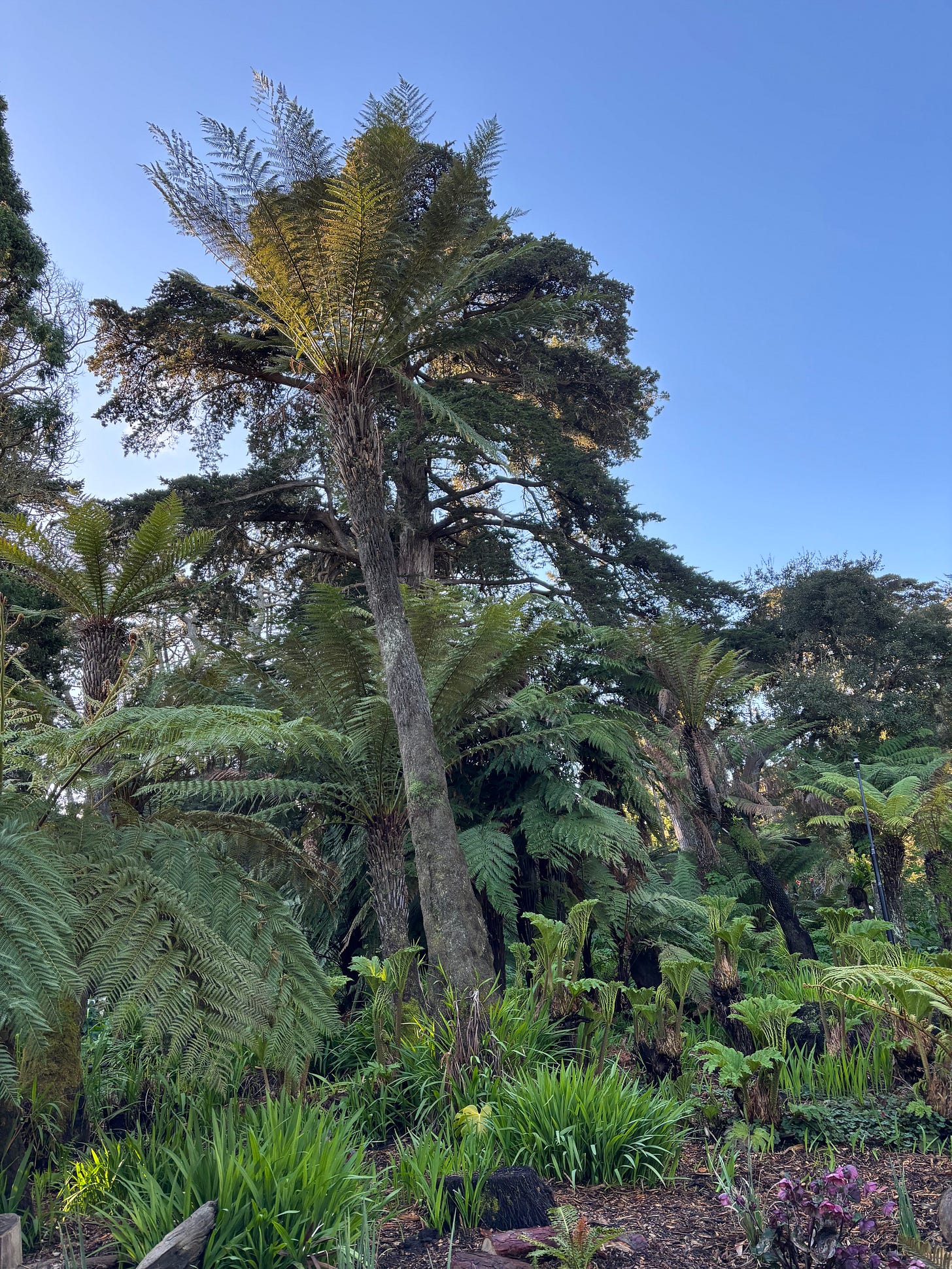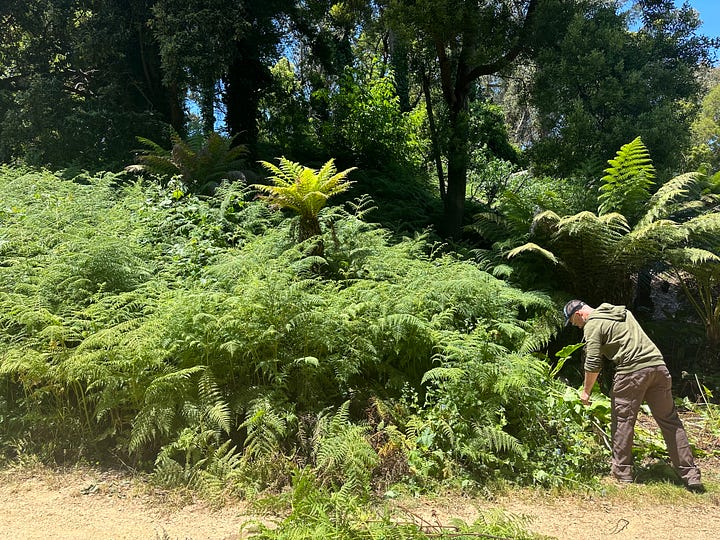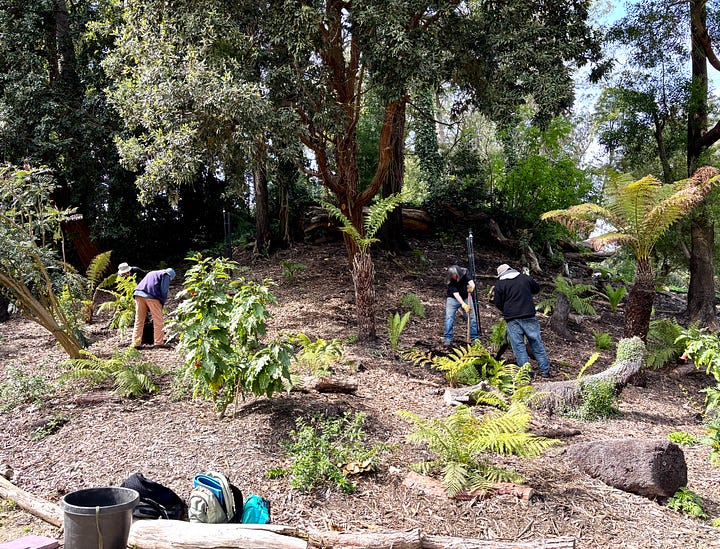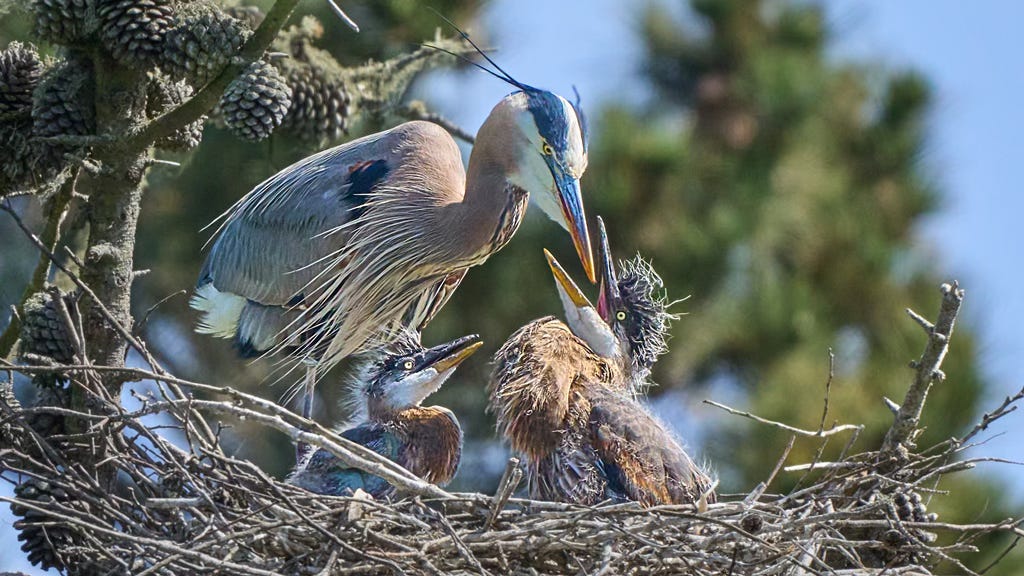Here’s a great one for word nerds: Pteridomania. The term was coined in 1855 to describe the fever for ferns that gripped the Victorian era. (Ferns belong to a class of plants called pteridophytes.) Fern mania was one of those rare fads that cut across social classes. As one writer put it, “Ferns and fern motifs appeared everywhere; in homes, gardens, art and literature.” There was even a popular custard cream cookie embossed with ferns.
And we can thank that fern craze for some of my favorite plants in Golden Gate Park: the otherworldly, Dr. Seussian tree ferns found in the Tree Fern Dell and bordering the edge of Mallard Lake. I learned about their background from a fantastic history and historic photos recently compiled by the group, Friends of the Tree Fern Dell and the Lily Pond.
Tree ferns were introduced around 1889, when a New Zealand acquaintance sent John McLaren a cigar box of live stalks. McLaren planted them around a pond he was creating to fill the park’s former chert quarry, now called the Lily Pond. Over the next decade, he planted hundreds more tree ferns around the pond and to create the Tree Fern Dell. Later, he planted clusters by Mallard Lake, in the de Laveaga Dell (now the site of the AIDS Grove), by Huntington Falls and along a passageway called the Rockery between the Conservatory and what was then the Music Grounds.
While the early ones planted came from New Zealand and Australia, there are over 600 species of tree ferns and they occur in tropical and warmer temperate areas around the world. A few species from other countries have since been added to the Dell.
Ferns are amazing plants. They’re one of the oldest plant families, a relic of our distant past (and I don’t mean the 1970s when ferns swung from the ceiling of every singles bar.) They date back some 385 million years ago to the Devonian era, when the first soils and seeds and insects developed and the earliest ancestors of land animals crawled out of the sea. Eons later, some species evolved trunks and grew into tree-like forms. Vast fern forests arose through which dinosaurs roamed.
Tree ferns still have that time-bending, pre-historic aura. To be deep in the Tree Fern Dell, or the Mallard Lake grove feels like traveling waaaaay back in time. Between the canopy of feathery fronds and the carpet of gunnera with its elephant-ear sized leaves, you’re enclosed in a world of only green -- the same verdigris palette that covered earth before flowering plants and trees appeared. It’s not hard to imagine a triceratops will come lumbering out of the brush.
Small wonder hippies in the 60s took to calling the Dell “Mescaline Grove.” Or that the producers of the Star Trek movie “The Wrath of Khan” chose a corner of the Tree Fern Dell to serve as the newly-forming “Genesis Planet” where Mr. Spock was buried --and would later be reborn.
McLaren planted six different species of tree ferns in the park. The most common Dicksonia antarctica, or Tasmanian tree fern, has a thick black trunk topped by a fountain of fronds. It can grow to be 80 feet tall, though McLaren kept the park’s specimens trimmed back to 20 or 30 feet because the chilly winter weather would damage the topmost leaves. Still he boasted, “San Francisco is the only place in this country I know they will grow all year around. Aye, it’s our climate.” The Tree Fern Dell, he once told a reporter “is the most beautiful spot in the park.”
But in recent decades his beloved spot suffered from neglect. The lush thicket of tree ferns around Lily Pond dried up and died from lack of watering. The Dell itself was overrun with bracken, blackberry and ivy, and littered with stumps and fallen tree ferns, recalled Cameron Chernoff, the gardener who manages the Dell. It was his first assignment after being hired by Rec and Park two years ago. “I was a little overwhelmed at first,” he acknowledged.

Enter a group of modern pteridomaniacs: the Friends of the Tree Fern Dell and Lily Pond. The organization was formed last year by a group of enthusiasts who have been working to help Chernoff bring the Dell and Lily Pond back to life.
The core of the Friends is a genial, tight-knit group of ten long-time park volunteers. “Most of us started as volunteers at the Botanical Garden nursery 10, 12 ,15 years ago. And we have stuck together…and picked up new people along the way,” said Mary Dee Beall. When the nursery was closed to outsiders during Covid, the group shifted their focus to work outside, taking on projects like building a fern stumpery in the Meso-American Cloud Forest and restoring the Ancient Plant Garden. And when there was no work for them in the Botanical Garden, they still got together weekly at each other’s homes to share plants and gardening tips and lunches that could go on for hours. “We just like to hang out with each other,” said Dan Yansura, the group’s informal leader.
Yansura is a retired Genentech scientist whose research included work on the hepatitis B vaccine. His interest in ferns began more than 40 years ago when he got interested in paleobotany. “I thought I should find the most primitive plants I can find that are still alive and try to grow them.” Ferns, he decided, were easier to work with than other primeval plants such as mosses. Because most varieties of tree ferns aren’t commercially available, he spent years mastering the challenging process of propagating ferns, which grow from spores not seeds. One source of spores was the tree ferns in Golden Gate Park. By now he has a collection of hundreds of ferns and another ancient plant lineage known as lycophytes. He even has a DNA sequencing lab in his garden shed, which he uses to sequence genes of species he wants to identify. As a volunteer for the Botanical Garden, Yansura helped establish its fern collection.
One day a year ago or so, Yansura and a fellow volunteer and fern enthusiast, Alex Adams, were walking by the Tree Fern Dell when they spotted Chernoff wrestling to pull out a trunk that was on its way toward the ground. They approached Chernoff. “You can replant that,” they told him, explaining the plant wasn’t dead, only dormant. Put back in the ground with proper mulching, the trunk, which is really a compressed system of roots, would recommence growing. Chernoff was glad for the counsel and asked if they’d be interested in helping him.
Fast forward to a Wednesday afternoon a few weeks ago. It was midday and the group, which had spent the morning working in the Ancient Plant Garden, was gathered for a quick lunch before getting to work in the Dell. Several people were sitting on a long blackened tree fern log, eating their sandwiches. Adams gestured to the log. “It’s about 150 years old. And it’s still alive.”
Unlike woody trees, tree ferns don’t have rings to date them. But because they grow about an inch a year, their age can be reckoned from their size. The log was more than 12 feet, hence 150 years old, which would make it one of the oldest plants in Golden Gate Park. Based on his measurements, Yansura thinks there are tree ferns in the Dell (standing or on the ground) that were planted by McLaren.

One of the volunteers handed him half a sandwich and he quickly ate it, then outlined the plans for the afternoon.
“We’ve got five tree ferns to plant and an Oceaniopteris gibba,” he announced. (I looked up the latter later; it’s a miniature tropical tree fern.)
Like any restoration project, the first task was to clear out what didn’t belong. They spent much of the past year pulling out bracken that covered the Dell in swaths as high as seven feet. “It's rather pretty, but it just takes over everything, and nothing can grow through it, “said Bronwyn Gundogdu, as she plucked out some young stems that were popping back up. She grew up in Melbourne Australia, and remembers hiking through woods filled with tree ferns.


While there’s still bracken and weeds to pull, these days the group is mostly focused on the much more pleasurable task of planting. Already they’ve put in some 50-to-60 ferns, including 39 tree ferns, and increased the varieties in the Dell from three to seven. “And we’re going to expand on that,” said Yansura.
The park nursery doesn’t grow tree ferns. So the plants have come from Yansura and a private nursery in South City. Members of Friends of the Fern Dell secured a $5,000 grant from San Francisco Beautiful which will help the group to buy even more. Next up, they plan to replant a hillside overlooking the Lily Pond that was covered with ivy and now is bare except for a few dead tree fern stumps.
That afternoon, Yansura directed the plantings. The group had only agreed to work on the restoration if they would have a hand in its design, he explained. He told Chernoff and his supervisor, “We don't want to just come and weed here, weed there. We wanted to have our own ideas in here.” Chernoff has been a willing collaborator. Now he listened as Yansura described another vision for the hillside: to raise some of the fallen logs and top them with birds nest ferns to add height to the new garden.
Slowly but surely, the Friends and Chernoff are reviving the Dell. To visit it today is again a step into the past — not a giant leap back millions of years, but a century ago when it flourished under McLaren’s loving hand.
**
If you want to help restore the Dell and Lily Pond, you can send a check to Rec and Park or give online at Give2SF. Either way make sure to note that your donation is for the Golden Gate Park Tree Fern Dell.
**
And another reminder that Heron Watch starts this Saturday. Volunteers from San Francisco Nature Education will be on hand at Blue Heron Lake to show you the nests and tell you all about the birds.







Wonderful story! I loved reading about the community that’s formed in what always feels like a magical part of the park.
I love this story! Not just because it's another fabulous chapter in the extraordinary life and lives unfolding in your 1017 acres - but because it's also like the stories you explore in *American Chestnut* and *Plastic* (and really themes that go back to your earliest feature stories): Pteridomania past and present helps us see humans at their most inspired and inspiring. Caring for a world that subtends and transcends the human. Able to see time beyond the 4000 weeks of a human life.